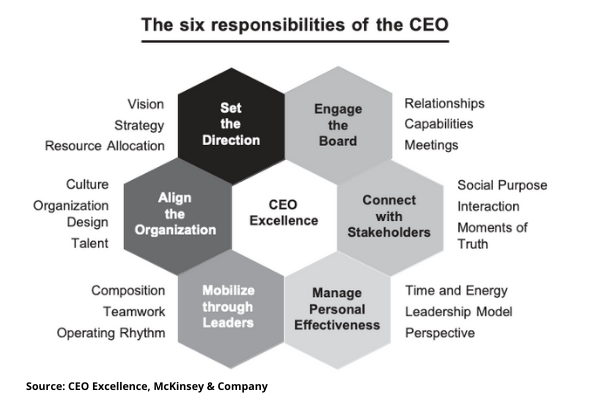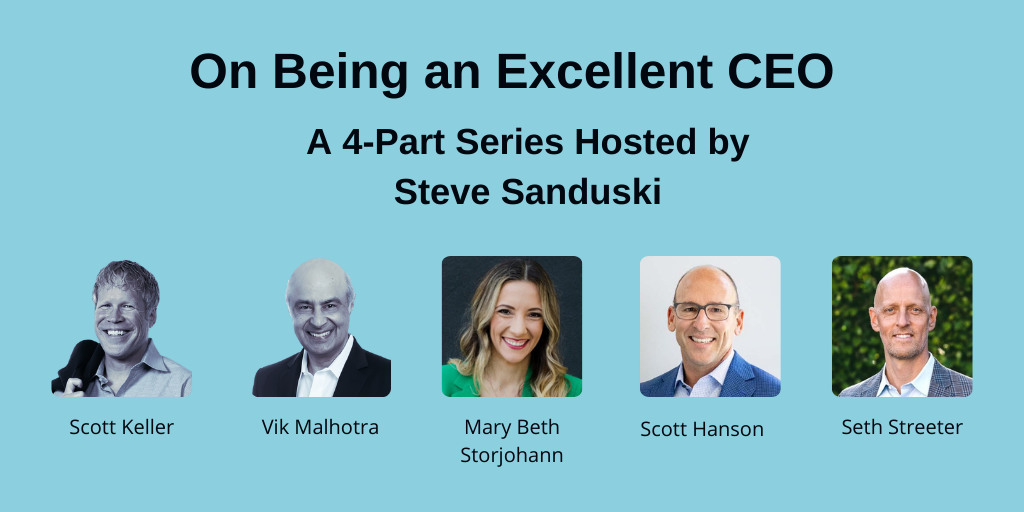It’s not easy being an excellent CEO. It’s a complicated job in an environment that’s constantly changing and you have full responsibility for everything that happens in your company. Yet, it can be highly rewarding and you have the ability to make a huge impact in people’s lives and in the communities in which you operate.
Here’s a four-part series on how to be and become an excellent CEO.
Part 1: The Nature of the CEO Role
Let’s begin by setting the stage for CEO role itself.
In an important book titled, CEO Excellence, three senior partners at McKinsey & Company—Scott Keller, Vik Malhotra, and Carolyn Dewar—drew two important conclusions.
- The CEO role can be reduced to six critical responsibilities and 18 associated practices.

Not surprisingly, each of those six responsibilities and 18 practices have an endless number of “things you can do” within those responsibilities and “a thousand different behaviors” that help drive results.
Unfortunately, writing a book about “endless things” and “a thousand different behaviors” would not be helpful to aspiring or existing CEOs. The real breakthrough in this book came from their second key conclusion.
- What separates the excellent CEOs from the average CEOs is the MINDSET that the excellent CEOs bring to bear on the six key responsibilities.
Specifically, the authors identified a key mindset that was associated with each of the six responsibilities.
| Key CEO Responsibility | Associated Mindset |
| 1. Set the Direction | Be Bold |
| 2. Align the Organization | Treat the Soft Stuff as the Hard Stuff |
| 3. Mobilize Through Leaders | Solve for the Team’s Psychology |
| 4. Engage the Board | Help Directors Help the Business |
| 5. Connect with Stakeholders | Start with “Why?” |
| 6. Manage Personal Effectiveness | Do What Only You Can Do |
What is Mindset?
As Scott Keller said to me, “Mindset is sort of a set of beliefs or assumptions that color one’s perception and predispose them to behave in a certain manner. What that means is from a certain mindset, stems many behaviors.”
It’s no stretch to say that one key to the fast growing firms is they have a bold mindset. They take the view that “fortune favors the bold.” As the authors wrote in CEO Excellence, leaders with a bold mindset are, “less a ‘taker’ of their fate and more a ‘shaper’;— constantly looking for and acting on opportunities that bend the curve of history.”
Here’s my full episode with co-authors Scott Keller and Vik Malhotra on being an excellent CEO.
CEO Excellence Series with Steve Sanduski
Part 2: Getting Promoted Into the CEO Role
You can become a default CEO by founding your company. Or, you can get promoted into the role like Mary Beth Storjohann did at Abacus Wealth Partners.
In this episode, Mary Beth and I talk about her game plan as a new CEO and how she will lead her company to its next stage of growth.
CEO Excellence Series with Steve Sanduski
Part 3: Growing Into the CEO Role as the Company Founder
In every new company, there’s the 0 to 1 phase of starting it, and then there’s the 1 to n phase of managing and growing it once it’s been proven to be viable.
The leadership skills needed to succeed at the 0 to 1 phase are different than at the 1 to n phase and to find both skillsets in the same person is not common. But it can be done as Allworth Financial co-founder and CEO Scott Hanson has shown.
In this episode, Scott and I talk about lessons he learned along the way as his company grew to more than $15 billion in assets under management and more than $100 million in revenue, key pivot points and the decisions he made, and what he thinks it takes to succeed as a CEO in today’s world.
CEO Excellence Series with Steve Sanduski
Part 4: Gracefully Exiting the CEO Role
At some point, it will be time for you to leave the CEO role. Ideally, you’ll leave on your terms like Seth Streeter of Mission Wealth did. Seth is a co-founder of the firm and after 20 years at the helm, he decided it was time to step aside and let the next generation of management step up (even though Seth is in his early 50s and remained with the company).
In this episode, Seth and I discuss how he knew the time was right for him to step aside, how he and the new CEO created “swim lanes” to make sure they’re clear on who does what, and the key lessons Seth learned in his long tenure in the CEO seat.
CEO Excellence Series with Steve Sanduski
3 Common Threads On Being An Excellent CEO
As I reflected on my CEO mini-series, I noticed three common threads among these leading CEOs. And these threads are not about tactics or strategies, rather, they’re about a way of thinking and being. Here’s what I discovered.
3 Common Threads
1. Growth Mindset.
I started the series with Scott Keller and Vik Malhotra of McKinsey and Company. The key thing I took away from that convo was what separates the excellent CEOs from the average CEOs is the MINDSET that the excellent CEOs bring to bear on the six key responsibilities of the CEO role.
In particular, Scott and Vik talked about a “bold” mindset when it came to setting the firm’s direction. Seth Streeter of Mission Wealth is a good example of putting that into action.
Seth told me that “growth mindset” is one of his firm’s top values. With this growth mindset versus a fixed mindset, they’re always asking themselves “What’s possible?”
Additionally, Seth and his team ask themselves, “Imagine if we were 10 times braver, 10 times bolder than we were today, how would we address this issue? How would we tackle this opportunity?”
The concept of a “growth versus fixed mindset” started bouncing around academia more than 30 years ago as Carol Dweck and her colleagues studied students’ attitudes about failure. It really caught fire in the business world about 15 years ago with the publication of Dweck’s book, Mindset: The New Psychology of Success.
So, what is a growth versus fixed mindset?
According to Dweck in this HBR article: “Individuals who believe their talents can be developed (through hard work, good strategies, and input from others) have a growth mindset. They tend to achieve more than those with a more fixed mindset (those who believe their talents are innate gifts). This is because they worry less about looking smart and they put more energy into learning.”
Interestingly, for my podcast guests, this growth mindset was not about growing just for the sake of getting bigger and making more money. It was about common thread #2—Impact.
2. Impact.
My second guest in the series, Mary Beth Storjohann, had to decide if she wanted to continue her lifestyle RIA, Workable Wealth, or merge it with multi-billion-dollar AUM RIA Abacus Wealth Partners. Ultimately, she merged with the much bigger firm. Why? So she could make a bigger impact.
Today, as the co-CEO of Abacus, she makes a very clear connection between growth mindset and impact, “We’re growing because we care about impact. We’re not just growing for growth’s sake.”
Scott Hanson is a fitness fanatic and he said for him, “Working out is right up there with food and air.” One day, while riding his bike, he had an epiphany and thought to himself, “I think God created me for more than just riding my bike.” He realized what he really liked was making an impact.
He said, “I have more satisfaction when I’m helping others do something, helping them accomplish things. And when I say work, it’s really getting around other people, people that I enjoy being around, trying to figure out solutions to interesting challenges and watching other people grow in their career and having successes and wins.”
Seth Streeter said, “Growth to us is synonymous with impact. The more we grow, the more opportunity there is for our team, the more families we can serve, and the more communities we can give back to. So, for us, growth fuels our purpose because our purpose is making an impact.”
3. Frameworks.
McKinsey is well-known for its frameworks. And, as consultants to some of the largest companies in the world, they excel at using frameworks to simplify the complex business of running mega-corporations.
In fact, their book, CEO Excellence, is one big framework. They’ve taken the all-encompassing role of the CEO and boiled it down to six key responsibilities and an associated mindset for each.
Frameworks are strategic and organizational models that offer shorthand ways to analyze, think about, and provide insight on what direction to go, what options to adopt, and how to lead.
One of the underpromoted benefits of using frameworks in your business is they can make your life much easier. For example, in Seth’s case, once he came across the integrator/visionary framework for leading a company, it instantly made sense. Seth is a visionary, his new CEO is an integrator, and this framework helps them both know what their “swim lanes” are so they don’t bore into each other.
For Scott, learning a framework for delegating back in 2000 was key. He said, “I was working like a dog, doing lots of different things, and I got really clear on what I’m good at and what I’m not good at. And the importance of delegating, true delegation, giving someone both the responsibility and the authority to do a task and the resources to do it. And I think from that point on, it was quite freeing for me. I don’t have to do everything here and I am not capable of doing everything and I need to surround myself with really good people.”
Scott’s delegation framework worked almost too well. By the time his firm reached about one billion in AUM, he was hardly working. And that’s when he had the epiphany I mentioned earlier and decided to double-down on making an impact.
Mary Beth is in the process of rolling out the EOS framework for managing her company. EOS is one of several business management systems that help leaders put structure around managing a complex organism called a “company.” I have my own business management system I use when coaching advisors that I’ve honed over the past 20+ years of coaching advisors that includes meeting rhythms, strategies, tactics, goal setting, the “soft stuff,” and measurement and accountability.
Now What?
My goal with this series is that it becomes an evergreen source of guidance for existing leaders and CEOs as well as those who aspire to senior leadership positions. Keep listening to these episodes. Share them with the next generation of leaders in your firm. Talk about them as a team. And like a book club, you could turn it into a “podcast club” for future study and conversation.





